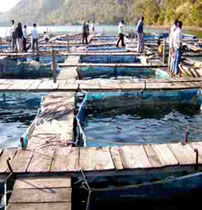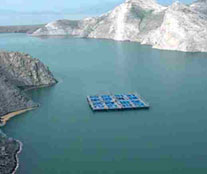
-
Average fish production from Indian reservoirs is about 15 kg/ha. If a proper stocking is taken up in open water bodies, this production can easily be increased up to 100 kg/ha. For optimum fish production from reservoirs, lakes, ponds, bheels etc., it is necessary to stock them with healthy fingerlings of above 100 mm size. Thus, cage culture offers in situ rearing of fry to fingerling before releasing them into the reservoirs and becomes the best option available for enhancement of fish production from large water bodies.
Description of technologyWebbing of the cages is made of HDPE (high density polyethylene). Mesh size of 6 to 8 mm and cage size of 3m×3m×3m are ideal for large and deeper open water bodies. The frame of the cage can be constructed from bamboo, teak or sal wood (preferably water resistant and light wood). Nut, bolts or other fasteners used to construct the cage should be of rustresistant material. The frame should be wide enough (1.5 to 2.0 ft) to support the cages and provide a working platform on the cages. This framework is also provided with HDPE barrels functioning as floats. Net cages are allowed at 1.0 m above the water level and fixed with ropes to four corners of the poles. Each cage is also covered from the top by using the same material. Bottom periphery of the cage is provided with sinkers so as to keep them stretched. Corners of the each cage unit are provided with anchors to keep the cage infrastructure stationery at a definite location in the water body. Stocking of fish is done with fry of length, 35 mm at a stocking density of 50-200 3 fry/m . 60 days of raising period is adequate for raising carp fingerlings in cages. It is advised to clean the webbing at weekly interval by brushing. Biofouling organisms such as algae, sponges and debris, if allowed, will obstruct the water exchange in the cages. Feeding of fish in cages is necessary for higher yield especially if productivity of the reservoir is poor. Formulated feed (rice bran 10%, GOC 40%, maize 7%, soybean 20%, Acetes 20%, vitamin mix 2%, mineral mix 1%) should be given to the fish (carps) at 3-5% of body weight, at least twice a day. At the end of 60 days, 100 to 120 mm sized fingerlings can be harvested. Three or four persons can manage to harvest one fish cage by lifting the net using four corner ropes attached up to the bottom of each cage. All fishes can be pushed at one corner of the cage to scoop out the confined fish at one end of the net and place them in buckets.
 Technology benefits
Technology benefitsThe production of fingerlings through cage aquaculture will improve country`s production in two ways;
- By regularly stocking open water bodies like lakes and reservoirs with desired varieties of fingerlings and thereby improving fish catch from these water bodies
- Fishfarmers, fishers, cooperative societies, community depending on the reservoir fishery or other open water bodies will be benefited through generation of income and livelihood by the application of this technology.
